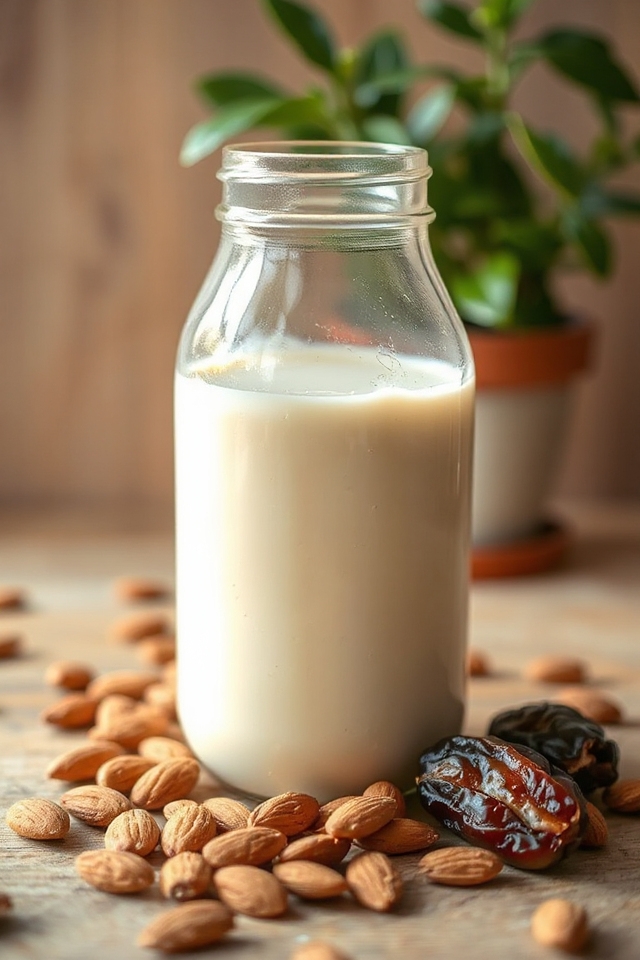Why You’ll Love This Homemade Almond Milk Recipe
Have you ever tasted homemade almond milk? If you haven’t, you’re really missing out!
I love how creamy and smooth it is, especially compared to store-bought versions. Making it at home means I control the sweetness and flavor, and there’s something so satisfying about blending those almonds into a delicious drink.
Plus, it’s incredibly easy and quick to whip up! Every time I make it, I feel good knowing I’m using natural ingredients.
It’s perfect in smoothies, coffee, or just on its own. Once you try it, you’ll wonder why you ever settled for the store-bought stuff!
Ingredients of Homemade Almond Milk
Making your own almond milk isn’t just a fun kitchen project; it’s also a game changer for your taste buds. Imagine creamy, dreamy almond milk that you crafted right in your own kitchen. No more wondering what’s in that carton from the store. You’ll know exactly what went into it, and you can tweak it to fit your taste perfectly.
Who knew that just a few simple ingredients could create something so delightful? Let’s get into the nitty-gritty of what you’ll need to make this luscious drink.
Ingredients for Homemade Almond Milk:
- 1/2 cup almonds
- 4 cups water
- 4 pitted dates
Now, let’s talk about those ingredients for a second. First off, almonds are the star of the show here. They give almond milk its creamy texture and nutty flavor. Make sure to use raw almonds, as roasted ones can change the taste.
Then we’ve water, which is obviously essential, but you can also get creative. Some folks like to use filtered water for an extra smooth finish.
And those pitted dates? They’re not just there for decoration—they add natural sweetness without the need for any processed sugars. You could swap them out for other sweeteners if you like, but dates bring a lovely caramel-like flavor that’s hard to beat.
Just remember, the fresher your ingredients, the better your almond milk will taste. So, are you ready to get blending?
How to Make Homemade Almond Milk

Alright, let’s plunge into the fun part—actually making that creamy, dreamy almond milk. Grab your 1/2 cup of raw almonds and toss them in a bowl. If you’ve got a little time to spare, soak those almonds in water for about 8 hours or overnight. I know, waiting is hard, but this step really helps soften them up and makes the blending process smoother.
If you forget to soak them, don’t sweat it. You can still make almond milk, it just might be a tad less creamy.
Once your almonds are all ready to go, drain and rinse them. Then, it’s time for the blender. Pour in your 4 cups of water—if you’re feeling adventurous, use filtered water for an extra touch of smoothness. Add those 4 pitted dates to the mix, too. They’re like little flavor bombs waiting to explode.
Now, blend everything together for about 2 minutes. You want to achieve a frothy, milky texture—just think of it as a health-conscious version of a milkshake.
After blending, grab a large clean white flour sack towel or a cheese cloth—yes, you might feel like a kitchen magician at this point. Place it over a wide pitcher or bowl, and carefully pour the almond mixture onto the cloth.
This is where the magic happens: as you squeeze and press, the almond milk will flow through, leaving you with a lovely, smooth liquid. The leftover almond pulp? Don’t just toss it! You can use it in smoothies, oatmeal, or even baking.
Now, pour your freshly made almond milk into a jar, pop it in the fridge, and enjoy the fact that you just made something incredibly wholesome. It’ll last you about 2 to 4 days, but I bet it won’t last that long because it’s just that good.
Homemade Almond Milk Substitutions & Variations
After whipping up a batch of homemade almond milk, you might wonder how to mix things up or tailor it to your taste.
I love adding a splash of vanilla extract or a sprinkle of cinnamon for extra flavor. If you prefer a sweeter milk, try using maple syrup or agave instead of dates.
For a creamier texture, blend in a handful of cashews or use less water. You can also experiment with different nuts like hazelnuts or macadamia nuts.
Each variation brings a unique twist, so don’t be afraid to get creative and discover what you enjoy the most!
What to Serve with Homemade Almond Milk
While enjoying a glass of homemade almond milk, you might wonder what delicious pairings complement its creamy texture and nutty flavor.
I love serving it alongside a warm slice of banana bread or a hearty bowl of oatmeal topped with fresh berries. It also makes a fantastic addition to smoothies, enhancing both taste and creaminess.
For a light snack, try pairing it with raw veggies and hummus. If you’re feeling indulgent, enjoy it with a piece of dark chocolate.
These combinations elevate the experience, making each sip of almond milk even more delightful and satisfying.
Additional Tips & Notes
To guarantee your homemade almond milk turns out perfectly every time, it’s essential to use high-quality almonds and fresh water. I recommend soaking the almonds overnight; it makes them easier to blend and enhances the creaminess.
If you prefer a sweeter milk, adjust the number of dates to your taste. Straining the milk with a fine cloth is vital for a smooth texture, so don’t rush this step.
Remember to keep your almond milk refrigerated and consume it within 2-4 days for the best flavor. You can also experiment by adding vanilla or cocoa for different variations!